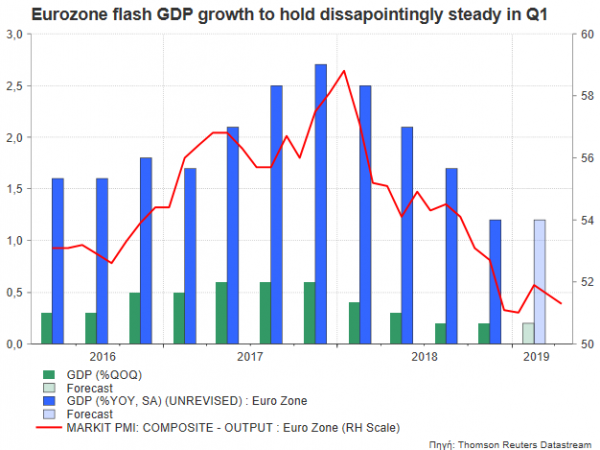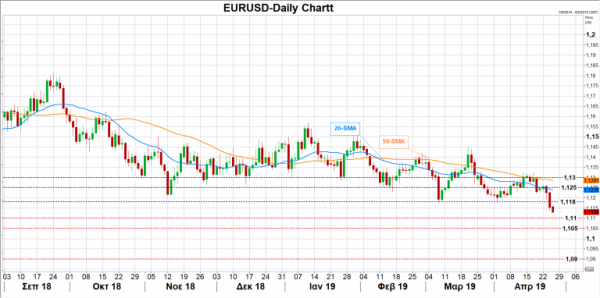The buttered euro is expected to come under fresh volatility in the wake of preliminary Q1 GDP growth data out of the Eurozone on Tuesday at 0900 GMT. The consensus is for a very modest growth as lack of progress in political and economic issues have probably kept investors’ interest away from EU markets.
Unlike other regions such as China and the US, the Eurozone seems to have started the year on a disappointing footing in the first quarter, with analysts forecasting only a modest expansion of 0.2% q/q and 1.1% y/y, the same as in Q4 2018. Actually the estimates should not be a big surprise. Given the turmoil around Brexit and recent calls from the Trump administration to unleash fresh tariffs on $11 billion EU products, investors may not feel it is safe to allocate funds in the bloc despite flourishing stock markets.
Incoming data especially in the tech-leader and export-led Germany, which barely avoided a technical recession in Q4, is a source of evidence that confidence and therefore economic performance was weak in the first quarter. During the first three months of the year, the German ifo business climate index that measures firms’ projections for the next six months tumbled near three-year lows, while latest readings for the month of April came out discouraging and below expectations, indicating a difficult start to Q2 as well. Manufacturing PMIs were in the worst position as a diminishing car industry and subdued global demand pressured the eurozone gauge far below the 50 level that separates contraction from expansion and towards six-year troughs, with Germany losing the most.
A decent rebound in the services PMI and retail sales readings, however, signaled that consumers are still supporting the economy even if they remain pessimistic about their future spending. Better conditions in the labour market reflected by a falling unemployment rate and a stronger wage growth, have potentially contributed positively to the services sector, leaving the blame for a GDP slowdown to fall entirely to the industrial sector.
On the monetary front, there is not much of a question. The European Central Bank (ECB) has clearly stated at its previous meeting early in April that interest rates will remain steady at current levels at least through the end of 2019 and for as long as necessary to ensure inflation’s convergence towards “the slightly below” 2.0% target. Policymakers have also decided to aid bank lending through a new series of quarterly targeted longer-term refinancing operations (TLTRO-III), starting in September 2019 and ending in March 2021, each with a maturity of two years. They also promised to continue reinvesting the principal payments from maturing securities purchased under the asset purchase program for an extended period of time past the date they start raising interest rates and beyond if needed.
While monetary strategy is not expected to change on May 8th as policymakers seem to have utilized most of their instruments and Draghi’s term as the ECB governor is approaching an end in October, a further slowdown in GDP growth, and particularly below the freshly downgraded 1.1% forecast for 2019 set by policymakers in April, would probably give rise to thoughts for some adjustments. April’s flash core CPI figure for release on Friday would be also reviewed by the central bank.
Turning to the possible market reaction, the melting euro could experience further selling if the eurozone economy performs worse than expected, with EURUSD probably diving towards the 1.11 psychological level. A bigger disappointment may open the door for the 1.1050-1.090 area.
Alternatively, the pair could rebound above the 1.1180 key support area in case the data beat analysts’ expectations. Resistance may then emerge between 1.1250 and 1.1300. It is also worth noting that the market is nearing oversold levels.















